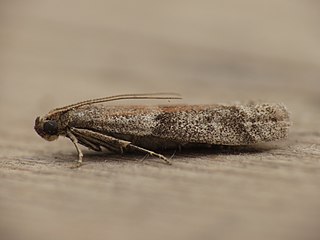
Nicotiana is a genus of herbaceous plants and shrubs in the family Solanaceae, that is indigenous to the Americas, Australia, Southwestern Africa and the South Pacific. Various Nicotiana species, commonly referred to as tobacco plants, are cultivated as ornamental garden plants. N. tabacum is grown worldwide for the cultivation of tobacco leaves used for manufacturing and producing tobacco products, including cigars, cigarillos, cigarettes, chewing tobacco, dipping tobacco, snuff, and snus.

The Pyralidae, commonly called pyralid moths, snout moths or grass moths, are a family of Lepidoptera in the ditrysian superfamily Pyraloidea. In many classifications, the grass moths (Crambidae) are included in the Pyralidae as a subfamily, making the combined group one of the largest families in the Lepidoptera. The latest review by Eugene G. Munroe and Maria Alma Solis retain the Crambidae as a full family of Pyraloidea.

The Pyraloidea are a moth superfamily containing about 16,000 described species worldwide, and probably at least as many more remain to be described. They are generally fairly small moths, and as such, they have been traditionally associated with the paraphyletic Microlepidoptera.

The almond moth or tropical warehouse moth is a small, stored-product pest. Almond moths infest flour, bran, oats, and other grains, as well as dried fruits. It belongs to the family of snout moths (Pyralidae), and more specifically to the tribe Phycitini of the huge snout moth subfamily Phycitinae. This species may be confused with the related Indian mealmoth or the Mediterranean flour moth, which are also common pantry pests in the same subfamily.

The Mediterranean flour moth or mill moth is a moth of the family Pyralidae. It is a common pest of cereal grains, especially flour. This moth is found throughout the world, especially in countries with temperate climates. It prefers warm temperatures for more rapid development, but it can survive a wide range of temperatures.

Ephestia elutella, the cacao moth, tobacco moth or warehouse moth, is a small moth of the family Pyralidae. It is probably native to Europe, but has been transported widely, even to Australia. A subspecies is E. e. pterogrisella.

Ephestia is a genus of small moths belonging to the family Pyralidae. Some species are significant pests of dry plant produce, such as seeds and cereals. Best known among these are probably the cacao moth and the Mediterranean flour moth.
The term flour moth refers to certain small moths of the family Pyralidae, whose caterpillars are a pest of flour:

Cadra is a genus of small moths belonging to the family Pyralidae. The genus Ephestia is closely related to Cadra and might be its senior synonym. Several of these moths are variously assigned to one or the other genus, in particular in non-entomological sources. Cadra and Ephestia belong to the huge snout moth subfamily Phycitinae, and therein to the tribe Phycitini.

Cadra calidella, the dried fruit or date moth, is a species of snout moth in the genus Cadra and commonly mistaken for the species Cadra figulilella. It thrives in warmer conditions and is found primarily in Mediterranean countries, although it can also be found in Central Asia, Kazakhstan, Transcaucasia, Caucasus, and the western part of Russia. It feeds on dried fruits, carobs, nuts and seeds, hence earning its colloquial name. This diet damages the food industry, and it is a common storage pest. Because of this, much research has been done to study ways to limit its reproduction rate and population size. It was first described by Achille Guenée in 1845.

Ephestia disparella is a species of snout moth in the genus Ephestia. It was described by George Hampson in 1901. It is found in southern Europe.
Ephestia inquietella is a species of snout moth in the genus Ephestia. It was described by Hans Zerny, in 1932. It is found in Morocco and Spain.
Ephestia animella is a species of snout moth in the genus Ephestia. It was described by Kari Nupponen and Jari Junnilainen in 1998 and is known from Russia. It has been recorded at an elevation range of 900 to 1000 metres.
Ephestia cypriusella is a species of snout moth in the genus Ephestia. It was described by Roesler in 1965, and is known from Cyprus, Greece and Turkey.

Ephestia mistralella is a species of snout moth in the genus Ephestia. It was described by Pierre Millière in 1874, and is known from France, Germany, Denmark, Fennoscandia, Estonia, Latvia and the Iberian Peninsula.

Ephestia parasitella is a species of snout moth in the genus Ephestia. It was described by Staudinger in 1859, and is known from Spain, France, the Benelux, Croatia and Russia.
Ephestia rectivittella is a species of snout moth in the genus Ephestia. It was described by Ragonot in 1901, and is known from Madagascar.

Ephestia unicolorella is a species of snout moth in the genus Ephestia. It was described by Staudinger in 1881, and is known from Iran, Turkey, Morocco, Azerbaijan and most of Europe.
Ephestia abnormalella is a species of snout moth in the genus Ephestia. It was described by Émile Louis Ragonot in 1887, and is known from Uzbekistan.
Ephestia columbiella is a species of snout moth in the genus Ephestia. It was described by Herbert H. Neunzig in 1990 and is known from North America, including Alabama, Florida, South Carolina and West Virginia.










